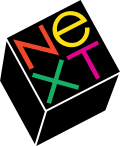 NeXTstation computer, monitor, keyboard, and mouse | |
| Developer | NeXT |
|---|---|
| Manufacturer | NeXT |
| Type | Workstation computer |
| Release date | September 18, 1990 [1] |
| Introductory price | US$4,995(equivalent to $12,000 in 2024) NeXTstation US$7,995(equivalent to $19,200 in 2024) NeXTstation Color US$6,500(equivalent to $15,600 in 2024) NeXTstation Turbo |
| Discontinued | 1993 |
| Operating system | NeXTSTEP, OPENSTEP, NetBSD (limited support) |
| CPU | Motorola 68040 |
| Memory | 8 MB - 32 MB 8 MB - 128 MB (Turbo) |
| Display | MegaPixel or MegaPixel Color, 1120 × 832 pixels |
| Graphics | 4-level greyscale or 4,096 colors |

NeXTstation is a high-end workstation computer developed, manufactured, and sold by NeXT from 1990 until 1993. It runs the NeXTSTEP operating system. The system was designed to be a lower-cost option compared to the company's upscale product, the NeXTcube. Compared to the cube, it removed a number of features and had limited expandability, allowing it to fit in a much smaller pizza-box form factor case.
Contents
There were two major series of the system released during its production run. The initial models were the NeXTstation and NeXTstation Color. Both were based on the Motorola 68040 processor running at 25 MHz. The Color units supported 12-bit color graphics (4,096 colors) stored in a separate 1.5 MB VRAM memory. Turbo versions were released in April 1992, which increased the speed of the processor to 33 MHz and increased the maximum amount of main memory from 32 to 128 MB of RAM.
Both the station and the cube initially used the same displays, the original MegaPixel display used on the original NeXT Computer. These used a single custom connector that included wiring for the monitor's built-in speaker and the Apple Desktop Bus connector for the keyboard. The mouse plugged into the keyboard. The MegaPixel Color Display moved to the (then) standard DB13W3 monitor connector, and the sound, keyboard and mouse connections were moved to the external NeXT Sound Box.
